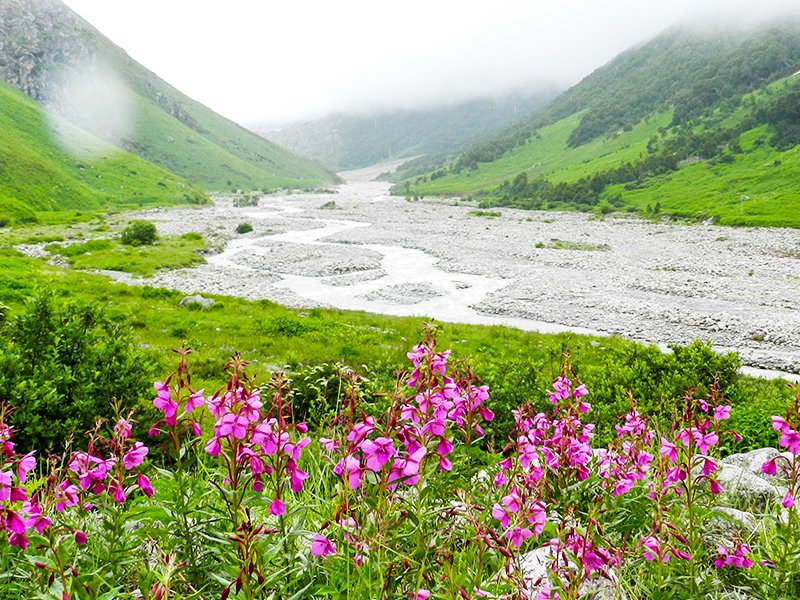Valley of Flowers
Published on August 23, 2025
High in the Himalayas of Uttarakhand lies a place that feels almost magical — the Valley of Flowers. This breathtaking valley, located at an altitude of about 12,000 feet (3,658 meters), is a vibrant carpet of alpine flowers that blooms during the monsoon season. Recognized as a UNESCO World Heritage Site, the Valley of Flowers is one of India’s most beautiful trekking destinations, drawing nature lovers, trekkers, and photographers from all over the world.
Where is the Valley of Flowers Located?
The Valley of Flowers lies in Chamoli district of Uttarakhand, near the famous Hemkund Sahib. It is part of the Nanda Devi Biosphere Reserve and spreads across 87 square kilometers. The valley is accessible only by trekking, which preserves its untouched beauty and pristine environment.
Why is the Valley of Flowers Famous?
-
Rare Alpine Flowers: During July to September, the valley bursts into color with over 500 species of flowers — including blue poppies, primulas, orchids, daisies, and anemones.
-
UNESCO Recognition: Declared a World Heritage Site in 2005 for its unique ecosystem and biodiversity.
-
Wildlife Sightings: Home to animals like the Himalayan black bear, snow leopard, musk deer, and colorful birds.
-
Scenic Beauty: Surrounded by snow-capped peaks, waterfalls, and glacial streams.

How to Reach the Valley of Flowers
The journey to the Valley of Flowers is as enchanting as the destination itself:
-
Reach Govindghat:
-
Start from Haridwar, Rishikesh, or Dehradun, and take a road trip to Govindghat (approx. 10–11 hours).
-
-
Drive to Pulna & Trek to Ghangaria:
-
From Govindghat, a short drive takes you to Pulna village, the starting point of the trek.
-
Trek 10 km uphill to Ghangaria, a small base camp where trekkers stay overnight.
-
-
Trek from Ghangaria to Valley of Flowers:
-
The next morning, trek 4 km to enter the valley. The path is scenic, passing through forests, bridges, and streams.
-
Since there are no roads to the valley, this entire route must be covered on foot, by mule, or using porters.
The Trek Experience
The trek to Valley of Flowers is considered moderate and suitable even for beginners with reasonable fitness. Here’s what makes it special:
-
Distance Covered: About 14 km one way (Govindghat to Valley of Flowers).
-
Trail Beauty: Waterfalls, snow-fed rivers, and panoramic views of towering peaks.
-
Base Village (Ghangaria): Offers simple hotels, guesthouses, and camps for overnight stay.
-
Duration: Most people plan a 4-5 day trip to fully explore the area, including a visit to Hemkund Sahib.
What to Expect in the Valley
Once inside the valley, you’ll see vivid colors everywhere. Unlike any garden made by humans, this valley is completely wild and untouched. The flowers grow naturally in clusters, changing shades every few days as new varieties bloom. The main highlights are:
-
Colorful Meadows: Endless stretches of pink, blue, yellow, and purple flowers.
-
Crystal Streams and Glaciers: Small streams flowing down from melting snow add to the beauty.
-
Snow-Clad Peaks: The valley is surrounded by majestic Himalayan mountains, giving stunning photo opportunities.
-
Tranquility: No noise, no vehicles, just the peaceful sound of nature.
Best Time to Visit
-
July to September is the best time when flowers are in full bloom.
-
In June, the valley is still melting from snow and only a few flowers appear.
-
By late September, the flowers start drying, but the valley still looks beautiful with autumn shades.
Weather in the Valley of Flowers
The temperature is pleasant during the day (12°C to 20°C) but drops at night (5°C to 7°C). Since this is monsoon season, rainfall is frequent, so carrying rain gear is essential.
Wildlife and Flora
Apart from rare flowers like brahma kamal, blue poppy, and cobra lily, the valley is rich in Himalayan wildlife. Trekkers may spot:
-
Himalayan monal (state bird of Uttarakhand)
-
Brown and black bears (rare sightings)
-
Snow leopard (extremely rare)
-
Musk deer and mountain goats
This diversity makes it a dream destination for nature enthusiasts and photographers.
Accommodation Options
There are no hotels inside the valley to maintain its natural ecosystem. The nearest place to stay is Ghangaria, which offers:
-
Basic guesthouses
-
GMVN (Garhwal Mandal Vikas Nigam) tourist rest houses
-
Private camps
Trekkers return to Ghangaria by evening, as overnight camping inside the valley is not allowed.
Nearby Attractions
-
Hemkund Sahib (4,632 meters): A revered Sikh pilgrimage site with a high-altitude lake. A 6 km steep trek from Ghangaria.
-
Badrinath Temple: One of the Char Dham pilgrimage sites, located nearby.
-
Joshimath: A spiritual and scenic town en route to the trek.

In Conclusion
The Valley of Flowers is more than just a trekking destination — it’s a living paradise. With its dazzling colors, peaceful atmosphere, and stunning Himalayan backdrop, this valley is perfect for adventure seekers, photographers, and nature lovers alike. Its recognition as a UNESCO World Heritage Site highlights its global significance and untouched charm.
Whether you’re visiting for its rare flowers, its scenic trails, or its spiritual vibe near Hemkund Sahib, this journey promises memories for a lifetime. If you want a well-organized experience, many Valley of Flowers trek packages are available, covering permits, accommodation, and guided treks to make your visit hassle-free.
_Valley_of_flowers,_Garhwal_Uttarakhand_India.jpg)